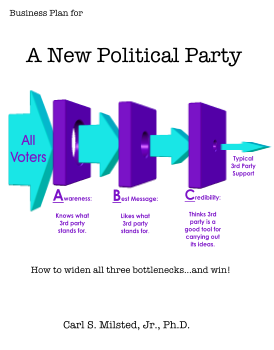Nonlinearity and the Bifurcation Fantasy
12. For whosoever hath, to him shall be given, and he shall have more abundance: but whosoever hath not, from him shall be taken away even that he hath..
--Matthew 13
I have treated the three factors as independent, and at times it is useful to do so. But in reality there is coupling. If you widen the first two bottlenecks, the third can widen automatically. That is, if your party and its candidates are well-known and well-liked, then they will be taken seriously.
Likewise, if you are taken seriously, then you will get more press coverage, which increases awareness. If you are taken seriously, and you are getting your message out, then more people will take more time to study your message. Some will get converted to your point of view (Bottleneck B).
We have the potential for what is called a bifurcation in chaos theory. That is, we have two or more semi-stable states for our system under current conditions, which one depends on earlier conditions. (Simple physical example: an automobile with the key turned on can be either running or not depending on whether the starter had been engaged in the past. The term “jump start” is commonly used for efforts to switch between bifurcation states.)
For example, if enough people who like the message were to donate heavily, advertising could be bought which could increase both awareness and credibility. This could increase the donor base which could buy more advertising, causing positive feedback to bring the party up to the next level.
This is the Bifurcation Fantasy. Many within the Libertarian Party buy into it. It is a compelling fantasy because it is potentially true. All else being equal, a bigger party has more credibility and awareness, which can sustain a bigger party. It is possible for the party to be small simply because it is small.
For this reason the Libertarian Party has gone through several cycles of hype-growth-collapse. Hype is generated by talking about the party’s potential vs. its actuality. This is used to achieve growth. However, should the growth be insufficient to match the hype, the party then collapses due to disappointment. I can think of at least three major hype cycles in the history of the LP:
The Crane Years: During the 1970s the LP achieved exponential growth just because it was new. The party was able to economically recruit early adopters who were ideologically aligned, had little preference between the D’s and R’s, and were amenable to Blue Sky arguments. Ed Crane was able to point out the resulting exponential growth to the media and to big donors, which resulted in coverage and a rich VP candidate for the Ed Clark presidential race. The LP hit a high point in 1980 and then collapsed. Ed Crane and many in his faction let themselves be muscled out by the radicals. In an interview in Liberty [November 1990] Crane openly stated that credibility required continued exponential growth. Once growth tapered off, the party was doomed in his opinion.
The Harry Browne Campaigns: Harry Browne was articulate, looked presidential, and had best-selling books to his credit. This provided a burst of new hope. Furthermore, Browne was masterful at self-promotion. His letters from the campaign trail were thrilling to read. His campaigns produced slick ads. His fundraisers were impressive. The fundraising goal thermometers indicated that funding was going up to the next level. Alas, reality crashed in when the polls closed. It turned out that the thermometers indicated gross receipts, not size of war chest – which was mostly already spent on fundraising. There was little money left to actually run the ads.
Project Archimedes: If you can acquire members at less cost than the new members subsequent contributions, then you are on the road to exponential growth. After this growth produces a large robust party, then productive action is possible. The gimmick behind Project Archimedes was to attempt profitable direct mail by “demographically filtering” direct mail lists in order to boost the response rate. That is, staff looked at the current LP demographic, filtered likely mailing lists by this demographic and send out the mailings. Alas, this trick did not work. (And as a long-term strategy it was dangerous, since a limited demographic political party cannot succeed.) The promise, however, did bring in enough money to fund a significant direct mail campaign which did temporarily boost party membership.
If conditions are right, such a hype campaign can take a political party to the next level. However, if conditions are not right, such hype campaigns result in expensive boom-and-bust cycles. The expense is not just in terms of money, but also in internal trust and credibility. A hype campaign that fails proves itself to be a lie. Writing a good hype-based fundraising letter requires skirting on the edge of the truth, which at times results in going beyond that edge.
It is my goal in this business plan to devise a growth model that requires a minimum of unsupportable hype, to reach the point of positive feedback through a safer route, based on solid actions that are worthwhile in and of themselves, even if they do not prove to be sufficient to get to that next level.
To see how such can be achieved, let us next look at the three bottlenecks in more detail, at ways to open them up with limited resources, and at ways to measure which bottlenecks are tightest.
Previous
| 1
| 2
| 3 | 4
| 5
| 6
| 7
| 8
| 9
| 10
| Next
Copyright 2007, Carl S. Milsted, Jr. All rights reserved.
|






